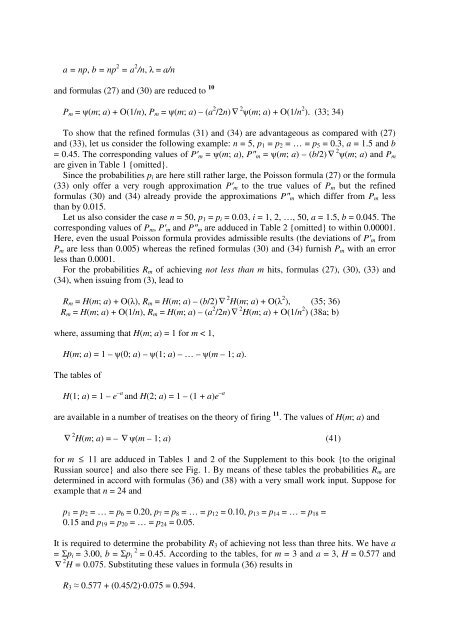kniga 7 - Probability and Statistics 1 - Sheynin, Oscar
kniga 7 - Probability and Statistics 1 - Sheynin, Oscar
kniga 7 - Probability and Statistics 1 - Sheynin, Oscar
Create successful ePaper yourself
Turn your PDF publications into a flip-book with our unique Google optimized e-Paper software.
a = np, b = np 2 = a 2 /n, = a/n<strong>and</strong> formulas (27) <strong>and</strong> (30) are reduced to 10P m = (m; a) + O(1/n), P m = (m; a) – (a 2 /2n) ∇ 2 (m; a) + O(1/n 2 ). (33; 34)To show that the refined formulas (31) <strong>and</strong> (34) are advantageous as compared with (27)<strong>and</strong> (33), let us consider the following example: n = 5, p 1 = p 2 = … = p 5 = 0.3, a = 1.5 <strong>and</strong> b= 0.45. The corresponding values of P) m = (m; a), P+ m = (m; a) – (b/2) ∇ 2 (m; a) <strong>and</strong> P mare given in Table 1 {omitted}.Since the probabilities p i are here still rather large, the Poisson formula (27) or the formula(33) only offer a very rough approximation P) m to the true values of P m but the refinedformulas (30) <strong>and</strong> (34) already provide the approximations P+ m which differ from P m lessthan by 0.015.Let us also consider the case n = 50, p 1 = p i = 0.03, i = 1, 2, …, 50, a = 1.5, b = 0.045. Thecorresponding values of P m , P) m <strong>and</strong> P+ m are adduced in Table 2 {omitted} to within 0.00001.Here, even the usual Poisson formula provides admissible results (the deviations of P) m fromP m are less than 0.005) whereas the refined formulas (30) <strong>and</strong> (34) furnish P m with an errorless than 0.0001.For the probabilities R m of achieving not less than m hits, formulas (27), (30), (33) <strong>and</strong>(34), when issuing from (3), lead toR m = H(m; a) + O( ), R m = H(m; a) – (b/2) ∇ 2 H(m; a) + O( 2 ), (35; 36)R m = H(m; a) + O(1/n), R m = H(m; a) – (a 2 /2n) ∇ 2 H(m; a) + O(1/n 2 ) (38a; b)where, assuming that H(m; a) = 1 for m < 1,H(m; a) = 1 – (0; a) – (1; a) – … – (m – 1; a).The tables ofH(1; a) = 1 – e –a <strong>and</strong> H(2; a) = 1 – (1 + a)e –aare available in a number of treatises on the theory of firing 11 . The values of H(m; a) <strong>and</strong>∇ 2 H(m; a) = – ∇ (m – 1; a) (41)for m ≤ 11 are adduced in Tables 1 <strong>and</strong> 2 of the Supplement to this book {to the originalRussian source} <strong>and</strong> also there see Fig. 1. By means of these tables the probabilities R m aredetermined in accord with formulas (36) <strong>and</strong> (38) with a very small work input. Suppose forexample that n = 24 <strong>and</strong>p 1 = p 2 = … = p 6 = 0.20, p 7 = p 8 = … = p 12 = 0.10, p 13 = p 14 = … = p 18 =0.15 <strong>and</strong> p 19 = p 20 = … = p 24 = 0.05.It is required to determine the probability R 3 of achieving not less than three hits. We have a= p i = 3.00, b = p i 2 = 0.45. According to the tables, for m = 3 <strong>and</strong> a = 3, H = 0.577 <strong>and</strong>∇ 2 H = 0.075. Substituting these values in formula (36) results inR 3 0.577 + (0.45/2)0.075 = 0.594.









